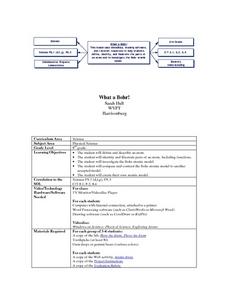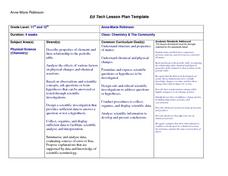Curated OER
pH and Red Cabbage Juice
Young scholars review properties of materials and define what pH tells them about matter. In this pH levels lesson, students determine whether materials are acids or bases using indicator substances.
Curated OER
Applied Science - Physics (K) Post Lab
Students are introduced to electricity. In this electricity lesson, students listen to the book Switch on, Switch off by Melvin Berger and discuss the use of electricity in light switches. They create a picture of an atom using pom...
Curated OER
Introduction to the Periodic Table of Elements
Students explain how the elements are arranged in the periodic table. In this chemistry instructional activity, students determine the subatomic particles for certain elements. They research the physical and chemical properties of an...
Curated OER
CONVECTION
Students experiment to produce a visual convection current in the classroom and compare it to the images taken of convection cells in the Sun. They analyze the source of the Sun's energy and this type of energy transport.
Curated OER
Destination: Station
Students examine the significance of the International Space Station. They view and discuss photos of rockets, space shuttles, and the International Space Station, develop a graph of objects in the sky, and create drawings.
Curated OER
Getting in Shape Again
Learners create rocket shapes out of pattern blocks. They draw a picture of a rocket, build a pattern block rocket following simple directions, and complete a graph of the shapes used.
Curated OER
Solar Cells
Students are able to answer basic questions about the process of turning light energy into electrical energy. They are introduced to the basic physics and chemistry behind the operation of a solar cell. Students explore how a single...
Curated OER
Casual Patterns in Simple Circuits
Students work in cooperative pairs to create a series circuit and a parallel circuit. Students compare and contrast the two different types of circuits using worksheets that are included.
Curated OER
What a Bohr!
Students define, identify and illustrate the parts of an atom, and investigate the Bohr atomic model. Students watch a multimedia presentation to understand an atom's parts and their functions. In groups, they create a model of an atom...
Curated OER
Biogeochemical Cycles
Students demonstrate comprehension of the energy sources of various cycles by completing mini stories. They demonstrate analysis of words by defining individual word parts and combining them to form definitions. Students demonstrate...
Curated OER
Chemistry & The Community
Students complete a Webquest which investigates the chemistry in items such as shampoo. They research the Internet, perform a lab experiment, and write a scientific lab report with their findings. Upon completion of the activities, the...
Curated OER
The Periodic Table
Eighth graders read and interpret the Periodic Table. They also make decisions on how to group and arrange different kinds of matter and draw the structure of atoms of pure elements. Finally, 8th graders contrast and compare basic...
Curated OER
Computer Activity-The Sun
In this computer activity worksheet, students visit a website and take a Virtual Tour of the Sun. While navigating through the site, they complete 16 fill in the blank questions.
Curated OER
Periodic Table Basics
In this periodic table learning exercise, students answers 10 fill in the blank questions by reading information form a periodic table. Then also complete Bohr Models of the atoms of 12 different elements.
Curated OER
The Periodic Table
In this science worksheet, learners use a periodic table to complete the first four rows of a chart. Students use the Internet or research books to complete the last column.
Curated OER
Get the Big Picture
In this atom, element, and atom worksheet, students will read descriptions of each and then use this information to fill in the blanks of 4 questions.
Curated OER
Introduction to the Periodic Table
In this periodic table instructional activity, students will label the atomic number, atomic mass, element name, and element symbol for oxygen. Then students will determine the characteristics of the different groups of elements on the...
Curated OER
Water - the (Nearly) Universal Solvent
In this water worksheet, learners explore the reasons why water is considered a universal solvent. Students compare different ways to change the dissolving rate of a solute. This worksheet has 11 fill in the blank and 8 matching questions.
Curated OER
Light
In this light activity, students read what makes light, the speed of light, and the electromagnetic spectrum. Students complete 12 matching, 8 fill in the blank, and 9 word problems.
Curated OER
More Chemical Bonding
In this chemical bonding worksheet, students review the three types of compounds: ionic, covalent, and polyatomic. Students practice drawing the covalent bonds of given compounds. This worksheet has 5 drawings and 13 fill in the blank...
Curated OER
Naming and Covalent Compounds
In this compounds worksheet, high schoolers practice naming compounds and classifying them as ionic, covalent, or polyatomic compounds. This worksheet has 12 fill in the blank and 12 problems to solve.
Curated OER
Chemical Bonding and Shapes of Molecules
In this chemical bonds worksheet, students review the different types of bonds, Lewis dot structures, ions, and molecule shapes. This worksheet has 10 matching, 17 multiple choice, and 3 drawing questions.
Curated OER
Electricity Crossword
In this electricity worksheet, learners complete a crossword puzzle by figuring out the vocabulary words associated with the 20 clues given.
Curated OER
Chem 152-Nuclear Chemistry
In this nuclear chemistry worksheet, students answer ten questions about radioactive decay, half life, electron capture and alpha emission.
Other popular searches
- Protons Neutrons Electrons
- Protons, Neutrons, Electrons
- Protons, Neutron, Electrons
- Protons and Neutrons
- Protons, Electrons, Neutrons
- Electrons, Neutrons, Protons
- Electrons and Protons
- Atoms and Protons
- Protons Neutrons, Electrons
- Atoms Electrons Protons

























